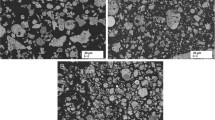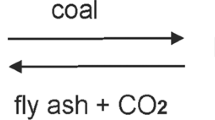Abstract
The extensive use of fossil fuels in energy production causes serious pollution of atmosphere with SO2, CO2, NOx, etc. In Estonia the electricity production is based mainly on the pulverized firing (PF) of low-grade local fuel – Estonian oil shale (EOS) which is characterized by a low calorific value (~9 MJ kg–1) and a high content of mineral matter (65–70%) from which approximately 50% are carbonates. Since 2004, also two boilers based on circulating fluidized bed combustion (CFBC) of EOS are in exploitation.
The present study is focused on the comparative investigation of the efficiency of different ashes collected from different technological points of CFB and PF boilers as sorbents for SO2. The influence of experimental temperature on the SO2-binding characteristics of ashes as well as the possibilities of activation of ashes (grinding, hydration) were investigated. It was shown that the SO2-binding capacity of initial ashes at 700°C and p(SO2)=190 mm Hg was for CFBC ashes 24–30 mg and for PF ashes 10–23 mg SO2 per 100 mg sample, the best binding capacities belonging to economizer ash (ECOA) and electrostatic precipitator ash from the 1st field (PESPA1f), respectively. However, during initial stage of binding the best results were obtained with air pre-heater ash (PHAA) and ESPA1f (both CFBC ashes). Grinding improved the SO2-binding ability, being the most effective in the case of bottom ash (BA) from CFBC and cyclone ash (PCA) from PF – increase in binding capacity 2 and 2.3 times, respectively. As compared to initial CFBC ashes, the binding characteristics of PF ashes remained lower even after grinding. Hydration and previous calcination improved the binding characteristics only of PF ashes. Hereby, the SO2-binding ability of CFBC ashes is better than of PF ashes and they are more promising sorbents for acidic gases, for example, for sulphur dioxide.
Similar content being viewed by others
References
A. Ots, Oil Shale Combustion Technology, Tallinn 2004, p. 768 [in Estonian].
A. Ots, H. Arro and L. Jovanovic, The Behaviour of Inorganic Matter of Solid Fuels during Combustion. Fouling and Corrosion in Steam Boilers; Beograd 1980, p. 276.
V Kikas (1997) International Cement-Lime-Gypsum 50 112 Occurrence Handle1:CAS:528:DyaK2sXitFyhsb4%3D
W Jozewics JCS Chang CB Sedman TG Brna (1988) Reactivity of Solids 6 243 Occurrence Handle10.1016/0168-7336(88)80065-2
N Karatepe A Ersoy-Merişboyu U Demirler S Küşükbayrak (1998) Thermochim. Acta 319 171 Occurrence Handle10.1016/S0040-6031(98)00400-6 Occurrence Handle1:CAS:528:DyaK1cXlvFChsL8%3D
J Fernándes MJ Renedo A Pesquera JA Irabien (2001) Powder Technol. 119 201 Occurrence Handle10.1016/S0032-5910(01)00263-7
KA Galos TS Smakowski J Szlugaj (2003) Appl. Energy 75 257 Occurrence Handle10.1016/S0306-2619(03)00039-4 Occurrence Handle1:CAS:528:DC%2BD3sXltVSksLg%3D
KT Lee S Bhatia AR Mohamed (2005) J. Therm. Anal. Cal. 79 691 Occurrence Handle10.1007/s10973-005-0597-6 Occurrence Handle1:CAS:528:DC%2BD2MXisFyns74%3D
KT Lee S Bhatia AR Mohamed KH Chu (2006) Chemosphere 62 89 Occurrence Handle10.1016/j.chemosphere.2005.03.094 Occurrence Handle1:CAS:528:DC%2BD2MXht1OrsbjO
T Kaljuvee A Trikkel R Kuusik (1997) Oil Shale 14 393
T Kaljuvee A Trikkel R Kuusik (2001) J. Therm. Anal. Cal. 64 1229 Occurrence Handle10.1023/A:1011561500091 Occurrence Handle1:CAS:528:DC%2BD3MXlslKqu74%3D
T Kaljuvee R Kuusik A Trikkel V Bender (2005) J. Therm. Anal. Cal. 80 591 Occurrence Handle10.1007/s10973-005-0699-1 Occurrence Handle1:CAS:528:DC%2BD2MXks1Cjuro%3D
A Trikkel et al. (2001) Estonian calcareous rocks and oil shale ash as sorbent for SO2. Academic Dissertation TTU Press Tallinn University of Technology 70
R Kuusik M Uibu K Kirsimäe (2005) Oil Shale 22 407 Occurrence Handle1:CAS:528:DC%2BD28XhvFWntg%3D%3D
JC Taylor (1991) Powder Diffraction 6 2 Occurrence Handle1:CAS:528:DyaK3MXlt1Gksrs%3D
RW Colin JC Taylor DR Cohen (1999) J. Sedimentary Res. 69 1050
Author information
Authors and Affiliations
Corresponding author
Rights and permissions
About this article
Cite this article
Kaljuvee, T., Toom, M., Trikkel, A. et al. Reactivity of oil shale ashes in the binding of SO2 . J Therm Anal Calorim 88, 51–58 (2007). https://doi.org/10.1007/s10973-006-8063-7
Received:
Accepted:
Published:
Issue Date:
DOI: https://doi.org/10.1007/s10973-006-8063-7




